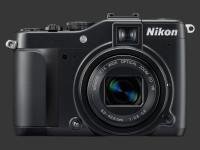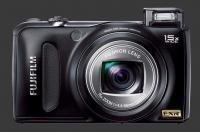Fujifilm Finepix F300 EXR Review
Fujifilm Finepix F300 EXR Performance - How well does it take pictures?
The Fuji Finepix F300 EXR shows excellent results in all aspects of image quality. Image noise is extremely low and well controlled producing highly usable images up to ISO 800 while keeping more details than the majority of fixed-lens digital cameras. Higher ISO sensitivities are usable too, although for smaller print sizes. ISO 6400 destroys image details and ISO 12800 seems there only to be able to write it on the box. Still, no compact digital camera produces usable results at those high sensitivities anyway.
The F300 EXR has two tricks to fight image-noise. One is the EXR-SN mode which captures up to 6 megapixels images by combining adjacent pixels at up to ISO 1600. The other is Pro Low-Light mode which uses 4 frames to form a single low-noise image, thus simulating ISO 1600 with ISO 400 images. The improvement for EXR-SN is visible but not drastic, certainly less than 1 stop improvement Pro Low-Light mode shows much better results. It does limit images to 6 megapixels with a slightly reduced angle-of-view but works well as long as the camera is held steadily. A tripod is obviously ideal for this. Here are 100% crops from ISO 1600 shots, the left-one taken in EXR-SN mode and the right-one in Pro Low-Light.
 ISO 1600 - EXR-SN ISO 1600 - EXR-SN |
 ISO 1600 - Pro Low-Light ISO 1600 - Pro Low-Light |
Compared to its predecessor, the F200 EXR, image quality is nearly identical. This is expected as the sensor-design is also nearly identical. This is excellent but not enough to catch up with the Nikon Coolpix P7000
Nikon Coolpix P7000 which is the first small camera to beat the F200 in terms of image noise. The P7000's lead only starts showing at ISO 800 with about a ½ stop advantage. Image noise is not the only measure of image quality though. Images from SuperCCD EXR sensors shows an incredible dynamic-range which is ahead of any other technology.
The F300 EXR has five settings for dynamic-range: 100%, 200%, 400%, 800% and Auto. Auto simply chooses among the other four settings depending on the current ISO sensitivity and several metering points. This means that Auto ISO cannot obviously choose a DR setting which is not available at the set ISO and that it can choose the wrong setting if the metering points do not detect the scene's entire dynamic-range. This may happen for example if there are very bright spots near the edges of the frame. The 800% setting is only available for image shot in EXR-DR mode and are limited to 6 megapixels.
 100% DR 100% DR |
 200% DR 200% DR |
 400% DR 400% DR |
 800% DR 800% DR |
Expanded dynamic-range is extremely useful for outdoor photography where the sky easily gets over-exposed in order to main subject-details. Anyone who has been on a general-interest tour probably suffered from visiting places when the light was too contrasty to obtain nice results. There are travel photography tours which plan for this and bring visitors to the right places at the ideal time of day.
The lens on this digital camera is an impressive achievement. Fuji managed to pack an ultra-wide 15X optical zoom lens in a 1.3" (33mm) thick body by using a double sliding-lens design. This takes on the original work Pentax used to fit a digital camera in a box of Altoid mints one step further. The principal is that while the lens retracts into the camera, two elements slide out of the way. Note that this is different than folded-optics which uses a prism to bend the optical path.
Optical distortion is nearly invisible. This is very impressive as only a very slight amount of barrel distortion can be seen at the widest setting. Equally impressive is that no vignetting can be seen throughout the entire optical zoom range. Another miracle is that we did not find any chromatic aberrations with this lens either. This has historically been a weak point for Fuji. The weak point of this otherwise awesome lens is strong softness near the corners of images, more so at wide-angle. The remainder of images show excellent sharpness though.

Color on the Fuji F300 is controlled by Film-Simulation: Provia, Velvia, Astia, B&W or Sepia. Provia is the default setting with natural but gently oversaturated colors. The Velvia setting boosts saturation across all colors giving a more punchy rendering without being over-the-top. Astia is the softest setting with some slight oversaturation compared to reality, it does show more gentle contrast though. The automatic white-balance system of the F300 EXR is very good though, rarely leaving a color-cast. It even handles artificial lighting surprisingly well. Custom white-balance is quite good not not perfect. The difference can be measured but it hard to see visually.
The metering system is simply superb and manages to balance shadows and highlights very well. This is certainly helped by this camera's exceptional dynamic range. In high-dynamic range mode, it is surprisingly difficult to make it burn-out highlights. This is the most impressive and advantageous of all EXR modes. One thing that users will need to know is that the dynamic range captured by the Fuji F300 EXR is still greater than what can be shown on the camera's LCD screen. This means it is possible that highlights look blown-out in the preview. Speaking of the LCD, its visibility is truly excellent, even in bright outdoor light.

The Fuji Finepix F300 does everything fast. Startup is quick, focusing is incredibly quick, zooming is very fast, shutter-lag is short and shot-to-shot speeds are great. Focusing remains fast down to very low light levels. In Playback mode, everything is also extremely fast, even zooming in on images.
The headline hybrid autofocus system does its job really well. Focusing is fast even without it but there is a noticeable improvement when using the Quick-AF setting with center-point autofocus, which is what lets the camera use Phase-Detection instead of Contrast-Detection. This is certainly among the fastest focusing non-DSLR cameras to date. Focus is also very reliable and rarely misses.
The Fuji Finepix F300 has image stabilization which proved extremely effective at all focal lengths. At both ends of the zoom, there is roughly a 3-stop advantage over the usual hand-held rule-of-thumb. Note that this camera generally prefers to increase the ISO, when the ISO is set to automatic, than to lower the shutter-speed and let the stabilizer handle it. Luckily, there are several automatic ISO modes which allow the user to choose an ISO limit from 400 to 1600. This lets users select which is the maximum ISO acceptable to them.

There are 4 continuous drive modes on the Fuji F300 EXR: Top-5, Final-5, High-Speed Top-23 and Final-23. Both Top-5 and Final-5 modes shoots at 1.5 FPS and can capture full-resolution images. The difference is that the Top-5 mode captures the 5 first images taken while the Final-5 captures the last 5, among up to 40. Top-23 and Final-23 modes work similarly except they shoot at 4.5 FPS but limit resolution to at most 3 megapixels. Unfortunately there is a significant lag between what the LCD displays and the photographs being taken. As its predecessors, entering playback mode oddly cancels the continuous shooting mode. Finally, battery-life is below average with the Auto-EXR mode being quite battery hungry. There are ways to deplete the battery even faster, such as enabling the clear-display mode which brightens the LCD and boosts its refresh rate.
Fujifilm Finepix F300 EXR Performance - How well does it shoot video?
Video capabilities of the F300 EXR are up to modern standards. This digital camera records widescreen 720p video with mono sound using a built-in microphone. Zooming is possible during video recording. Autofocus is always continuous while recording video. Unlike autofocus for still images, the Finepix F300 EXR has a hard time keeping up with movements in movie-mode. Camera movements are problematic as it can take over one second for the camera to refocus itself after the camera is moved. During panning, the camera cannot maintain focus.

The video quality is generally acceptable but it shows difficulties with small light sources which causes vertical streaks to be recorded. The microphone unfortunately records a lot of sound from within the camera. It also records ambient sound but has a short range, so everything more than several feet away becomes noise.
As mentioned earlier in the review, video recording starts with only a short delay and stops instantly. There are guidelines that help setting up framing but they are not entirely accurate as movie-recording uses a slightly reduced field-of-view. This means that parts within the guidelines still get chopped when recording starts. Certainly not a good implementation and so once again we strongly urge manufacturers to use a dedicated video mode which sets up the sensor and preview correctly.
Fujifilm Finepix F300 EXR Conclusion
The Fuji Finepix F300 EXR is one of the most compelling compact cameras available. Its excellent image quality is class-leading in terms of dynamic-range and second-best in terms of image-noise. What is more is that this is one of the fastest compact cameras when it comes to focusing and operational speed. Certainly it does not have the burst rates of CMOS cameras or external controls of the latest advanced compacts but it brings something distinctly different. The ultra-wide angle 15X optical zoom lens in a very compact body and manual-controls make this digital camera among the most versatile.

The tough choice is selecting the best digital camera for your needs. For outstanding dynamic-range and focus speed, look no further than the Fuji Finepix F300 EXR. Image quality is also so close to the best compact that one loses very little in selecting this model. Only at the higher ISOs than there is a measurable difference between this one and the Nikon Coolpix P7000
Nikon Coolpix P7000. The more important choice is about controls and efficiency. Recent high-end compacts like the Nikon and certain models for Canon and Panasonic where designed for efficiency with dual control-dials and many more buttons than the F300 EXR. The Auto-EXR mode gives all control to the camera rather than the photographer but gives excellent results with little effort. There is no one best choice, but clearly this digital camera is an extremely capable travel-zoom.
 |
Please Support Neocamera
All information on Neocamera is provided free of charge yet running this website is a huge endeavor. Purchases made via affiliate links found throughout the site help keep it running and up-to-date. There is no additional cost to you, so please consider buying via these links to our affilates:
If you found any information on this site valuable and did not purchase via our affiliate links, please considering donating via PayPal:
Any amount will be greatly appreaciated. Thank you for your support!
Fujifilm F300 EXR Highlights

Sensor-Size: 8 x 6mm

Actual size when viewed at 100 DPI
| 12 Megapixels Travel Zoom | ISO 100-3200 |
| 15X Ultra-Wide Optical Zoom | Shutter 1/2000-8s |
| Built-in Stabilization | Full manual controls |
| 1.5 FPS Drive, 5 Images | Custom white-balance |
| 1280x720 @ 24 FPS Video Recording | Spot-Metering |
| 3" LCD 460K Pixels | Lithium-Ion Battery |
| Secure Digital High Capacity, Internal Memory |
Fuji F300 EXR vs F200 EXR
The Fuji Finepix F300 EXR features a significantly redesigned body, an all new lens, and an updated sensor compared to the F200 EXR. The lens alone is probably worth the upgrade both for its ultra-wide and super-telephoto reach, tripling the zoom range compare to its predecessor. Despite the much larger optical zoom, the F300 EXR is not much larger than the F200 EXR. The thickness did increase just enough to push it into compact category, while the F200 is an ultra-compact.
The new EXR sensor produces trivially improved image quality while keeping the dynamic range and low noise characteristics of the original EXR sensor. Having already significantly improved dynamic-range, Fuji added Phase-Detection to give their new sensor ultra-fast focusing speeds. This makes the F300 EXR the fastest focusing camera in its class, although the improvement is not as drastic as expected. There are probably technical reasons for this but the F300 is still behind most DSLRs when it comes to focusing. Also Fuji could not put many Phase-Detection sites on the chip, so ultra-fast focusing is only available for the center-point.
The next major change to the EXR sensor is its ability to capture 720p HD video which is now expected of all modern cameras. There has been some shuffling around the body in terms of components but most of them work the same way as before. The F300 EXR gains a direct video-record button, replacing the face-detection button, and also gains a think rotary dial around the 4-way controller. The flash has been turned into a slightly annoying pop-up flash but it can be used as a direct flash-disable control.
Updates
2024.11.18

Best 2024 Photography Gifts for Every Budget
Great gifts for photographers and photo enthusiasts selected for every budget among the best products of 2024.
2024.08.07

Eye Protection Tips for Professional Photographers
The four main considerations for professional photographers regarding eyewear.
2024.07.14

Fujifilm X100VI Review
Flagship fixed-lens compact digital camera with a 40 MP sensor and Image-Stabilization, a first for the series. Retro design featuring dual control-dials, plus direct ISO, Shutter-Speed and EC dials. Its hybrid viewfinder can switch between EVF and OVF mode.
2024.05.09

Fujifilm GFX100 II Review
Flagship 102 Megapixels Medium-Format Mirrorless Digital Camera with 8-Stop 5-Axis IBIS, 8 FPS Drive, 8K Video and 400 MP Super-Resolution capture in a weatherproof and freezeproof body with dual control-dials and dual memory-card slots.
2024.04.03

Fujifilm X-T5 Review
Newest Fujifilm flagship boasting a 40 MP APS-C sensor, 5-axis IBIS with 7-stop efficiency, 15 FPS continuous drive, 6.2K Video capture, dual control-dials and dual SDXC UHS-II slots in a sturdy weatherproof and freezeproof body.
2023.11.20

Best Digital Cameras of 2023
Find out which are the Best Digital Cameras of 2023. All the new Mirrorless Digital Cameras from entry-level to high-end professional.
2023.07.10

Fujifilm X-H2 Review
40 Megapixels APS-C Hybrid Mirrorless Digital Camera with 7-stop IBIS. Fastest shutter ever and 8K video capture. Large builtin EVF with 0.8X magnification and 5.8 MP, plus an Eye-Start Sensor. Packed with features and large number of controls in a weatherproof and freezeproof body.
2023.05.07

Sony FE 20-70mm F/4G Review
Review of the unique Sony FE 20-70mm F/4G lens. The optical zoom of this lens spans ultra-wide-angle and medium focal-length coverage, making it one of the most versatile Full-Frame lenses on the market.
2023.01.15

Huion Inspiroy Dial 2 Review
Review of the Huion Inspiroy Dial 2 tablet, a medium sized drawing surface with dual dials and customizable buttons. Connects via USB-C or Bluetooth 5.0 with Windows, Linux and Android support.
2022.12.08

How to Pack for a Photo Trip
Find out how to pack for a travel photography trip, carry your gear safely while meeting airline regulations.
2022.11.13

Best Digital Cameras of 2022
The best digital cameras of 2022. A short list of the most outstanding models in their respective categories. Choose one for yourself or as a gift.
2022.09.21

Pentax DA* 60-250mm F/4 SDM Review
Review of the Pentax DA* 60-250mm F/4 SDM, the constant-aperture telephoto zoom with the highest zoom-ratio on the market.












